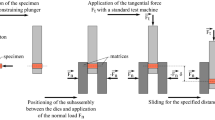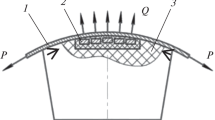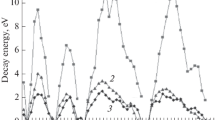Abstract
The paper refers to a new method to quantify the energy losses due to frictional effects and imperfections in contacts in the case of real industrial tribomechanical systems. Whereby energy losses represent an integral indicator of quality of the real industrial tribomechanical system, in terms of the characteristics of the contact element materials, geometric accuracy, and manufacturing and assembly errors. This paper presents a complex theoretical model based on the differential equation of motion of a real tribomechanical system down a steep plane. The outputs of the theoretical model are exact mathematical expressions that define the current values of the coefficient of friction and the friction-caused energy losses. The measuring system enables the quantification of current values of the distance traveled per unit of time. Based on a series of experimentally determined values of distance traveled per unit of time, the values of energy losses of the real industrial tribomechanical system are determined using the developed theoretical model and the appropriate software support. The obtained results indicate a high reliability, a large potential, and a wide range of possible applications of the proposed method.













Similar content being viewed by others

References
Blau PJ (2001) The significance and use of the friction coefficient. Tribol Int 34(9):585–591. https://doi.org/10.1016/S0301-679X(01)00050-0
Nuruzzaman DM, Chowdhury MA (2013) Friction coefficient and wear rate of different materials sliding against stainless steel. Int J Surf Eng Interdiscip Mater Sci (IJSEIMS) 1(1):33–45. https://doi.org/10.4018/ijseims.2013010103
Alaci S, Muscă I, Pentiuc ȘG (2020) Study of the rolling friction coefficient between dissimilar materials through the motion of a conical pendulum. Materials 13:5032. https://doi.org/10.3390/ma13215032
Diez-Ibarbia A, Fernandez-Del-Rincon A, Garcia P et al (2018) Assessment of load dependent friction coefficients and their influence on spur gears efficiency. Meccanica 53:425–445. https://doi.org/10.1007/s11012-017-0736-8
Ivkovic B, Djurdjanovic M, Stamenkovic D (2000) The influence of the contact surface roughness on the static friction coefficient. Tribol Ind 22(3–4):41–44. http://www.tribology.fink.rs/journals/2000/3-4/1.pdf. Accessed 20 April 2023
Chowdhurya MA, Nuruzzamana DM, Miaa AH, Rahamana ML (2012) Friction coefficient of different material pairs under different normal loads and sliding velocities. Tribol Ind 3422(1):18–23. http://www.tribology.fink.rs/journals/2012/2012-1/3.pdf. Accessed 20 April 2023
Hwang YM, Chen CC (2020) Investigation of effects of strip metals and relative sliding speeds on friction coefficients by reversible strip friction tests. Metals 10:1369. https://doi.org/10.3390/met10101369
Harouz R, Lakehal A, Khelil K, Dedry O, Hashemi N, Boudebane S (2022) Dry sliding friction and wear of the WC/TiC-Co in contact with AL2O3 for two sliding speeds. Facta Univ Ser: Mech Eng 20 (1):37–52. https://doi.org/10.22190/FUME200310039H
Smolin AY, Filippov AV, Shilko E (2021) V. Friction behavior of aluminum bronze reinforced by boron carbide particles. Facta Univ Ser Mech Eng 19(1):51–65
Otero JE, de la Guerra Ochoa E, Tanarro EC, del Rio López B (2017) Friction coefficient in mixed lubrication: a simplified analytical approach for highly loaded non-conformal contacts. Adv Mech Eng 9(7):1–11. https://doi.org/10.1177/1687814017706266
Čípek P, Vrbka M, Rebenda D, Nečas D, Křupka I (2020) Biotribology of synovial cartilage: a new method for visualization of lubricating film and simultaneous measurement of the friction coefficient. Materials 13:2075. https://doi.org/10.3390/ma13092075
Chung JO, Go SR, Choi HB, Son TK (2020) Temperature dependence of friction coefficient and transfer film formation in organic friction materials containing different abrasive components. Ind Lubr Tribol 72(4):483–489. https://doi.org/10.1108/ILT-10-2019-0427
Folle LF, Caetano dos Santos Silva B, Sousa de Carvalho M, Zamorano LGS, Coelho RS (2022) Evaluation of the friction coefficient for TRIP1000 steel under different conditions of lubrication, contact pressure, sliding speed and working temperature. Metals 12:1299. https://doi.org/10.3390/met12081299
Wen Q, Liu M, Zhang Z, Sun Y (2022) Experimental investigation into the friction coefficient of ball-on-disc in dry sliding contact considering the effects of surface roughness, low rotation speed, and light normal load. Lubricants 10:256. https://doi.org/10.3390/lubricants10100256
Argatov II, Chai YS (2021) An analytical approach to the third body modelling in fretting wear contact: a minireview. Facta Univ Ser Mech Eng 19(1):125–131. https://doi.org/10.22190/FUME210103018A
Cao H, Zhu M, Li B, Lu X, Li H, Guo M, Wu F, Xu Z (2022) Theoretical study of the friction coefficient in the M-B model. Coatings 12:1386. https://doi.org/10.3390/coatings12101386
El-Bahloul SA (2020) Pre-drilling effect on thermal friction drilling of cast aluminum alloy using thermo-mechanical finite element analysis. J Appl Comput Mech 6(1):1371–1379. https://doi.org/10.22055/jacm.2020.34682.2455
Wei S, Wei H, Saxen H, Yu Y (2022) Numerical analysis of the relationship between friction coefficient and repose angle of blast furnace raw materials by discrete element method. Materials 15:903. https://doi.org/10.3390/ma15030903
Afrasiabi M, Saelzer J, Berger S, Iovkov I, Klippel H, Röthlin M, Zabel A, Biermann D, Wegener K (2021) A numerical-experimental study on orthogonal cutting of AISI 1045 steel and Ti6Al4V alloy: SPH and FEM modeling with newly identified friction coefficients. Metals 11:1683. https://doi.org/10.3390/met11111683
Evin E, Daneshjo N, Mareš A, Tomáš M, Petrovčiková K (2021) Experimental assessment of friction coefficient in deep drawing and its verification by numerical simulation. Appl Sci 11:2756. https://doi.org/10.3390/app11062756
Khalaf AA, Hanon MM (2022) Prediction of friction coefficient for ductile cast iron using artificial neural network methodology based on experimental investigation. Appl Sci 12:11916. https://doi.org/10.3390/app122311916
Xu SH, Cheng DJ, Zhang SW (2022) Analysis of friction fluctuations mechanism of a preloaded roller linear motion guide based on a new 5-DOF dynamic stiffness model. Measurement 190:110768. https://doi.org/10.1016/j.measurement.2022.110768
Soleimanian P, Ahmadian H (2021) Modeling friction effects in lubricated roller guideways using a modified LuGre model. J Vib Control 28(19–20):107754632110139. https://doi.org/10.1177/10775463211013922
Oh KJ, Khim G, Park CH, Chung SC (2019) Explicit modeling and investigation of friction forces in linear motion ball guides. Tribol Int 129:16–28. https://doi.org/10.1016/j.triboint.2018.07.046
Krampert D, Unsleber S, Janssen C, Reindl L (2019) Load measurement in linear guides for machine tools. Sensors 19(15):3411. https://doi.org/10.3390/s19153411
Whitican SM, Van Karsen C, Blough J (2019) Towards the development of a model for nonlinear elements in machine tools. In: Kerschen G (eds) Nonlinear Dynamics 2019, Conference Proceedings of the Society for Experimental Mechanics Series, vol. 1, pp. 405–417. Springer, Cham. https://doi.org/10.1007/978-3-319-74280-9_46
Zhuravlev VP (2013) On the history of the dry friction law. Mech Solids 48:364–369. https://doi.org/10.3103/S002565441304002X
Mihajlović G, Gašić M, Savković M, Mitrović S, Tadić B (2017) Vibroplatform modeling with allowance for tribological aspects. J Frict Wear 38:184–189. https://doi.org/10.3103/S1068366617030102
Vukelic D, Todorovic P, Simunovic K, Miljojkovic J, Simunovic G, Budak I, Tadic B (2021) A novel method for determination of kinetic friction coefficient using inclined plane. Tehnički vjesnik 28(2):447–455. https://doi.org/10.17559/TV-20201101051835
Euler L (1750) Sur le frottement des corps solides. Memories de l’academie des sciences de Berlin 4:122–132
Miljojković J, Kočović V, Luković M, Živković A, Šimunović K (2022) Development of a modular didactic laboratory set for the experimental study of friction. Tehnički vjesnik 29(1):269–277. https://doi.org/10.17559/TV-20210925171045
Brzaković LJ, Kočović V, Mitrović S, Busarac N, Tadić B (2022) A method for determination of kinetic friction coefficient under dynamic loading conditions. Roman J Phys 67:905. https://rjp.nipne.ro/2022_67_9-10/RomJPhys.67.905.pdf. Accessed 20 April 2023
Brzaković LJ, Milovanović V, Kočović V, Šimunović G, Vukelić DJ, Tadić B (2022) Relation between kinetic friction coefficient and angular acceleration during motion initiated by dynamic impact force. Tehnički vjesnik 29(5):1622–1628. https://doi.org/10.17559/TV-20220408155435
Funding
This research was supported by the Ministry of Education, Science and Technological Development of the Republic of Serbia.
Author information
Authors and Affiliations
Contributions
All authors contributed to the study’s conception and design. Dragomir Miljanić: conceptualization, resources, funding acquisition, and writing—review and editing. Vladimir Milovanović: methodology, investigation, validation, visualization, and writing—original draft. Djordje Vukelić: methodology, software, visualization, and writing—review and editing. Dragan Rakić: formal analysis, software, and supervision. Branko Tadić: conceptualization, methodology, project administration, writing—original draft, and supervision. All authors read and approved the final version of the manuscript.
Corresponding author
Ethics declarations
Competing interests
The authors declare no competing interests.
Additional information
Publisher's Note
Springer Nature remains neutral with regard to jurisdictional claims in published maps and institutional affiliations.
Rights and permissions
Springer Nature or its licensor (e.g. a society or other partner) holds exclusive rights to this article under a publishing agreement with the author(s) or other rightsholder(s); author self-archiving of the accepted manuscript version of this article is solely governed by the terms of such publishing agreement and applicable law.
About this article
Cite this article
Miljanić, D., Milovanović, V., Vukelić, D. et al. On the determination of the friction-caused energy losses and its potential for monitoring industrial tribomechanical systems. Int J Adv Manuf Technol 129, 497–511 (2023). https://doi.org/10.1007/s00170-023-12288-y
Received:
Accepted:
Published:
Issue Date:
DOI: https://doi.org/10.1007/s00170-023-12288-y



